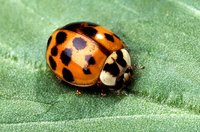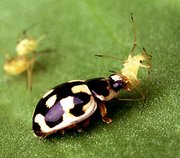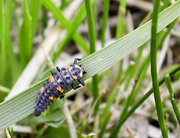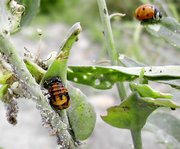Ladybugs
|
|
| Lady beetles | ||||||||||||||
|---|---|---|---|---|---|---|---|---|---|---|---|---|---|---|
 Asian Lady Beetle | ||||||||||||||
| Scientific classification | ||||||||||||||
| ||||||||||||||
| Subfamilies | ||||||||||||||
|
Chilocorinae |
Ladybug_on_a_leaf.jpg
Ladybirds_mating.jpg
Unusual_pattern.jpg
Ladybirds (Commonwealth English), also known as ladybugs (American English, Canadian English) or lady beetles (some scientists favor this) are a family, Coccinellidae ("little sphere"), of beetles; the name is thought to allude to the Blessed Virgin Mary in the Catholic faith. Ladybirds are found worldwide, with over 4,500 species described, more than 450 native to North America alone. Ladybirds are small insects, ranging from 1 mm to 10 mm (0.04 to 0.4 inches), and are usually yellow, orange, or red with small black spots on their carapace, and black legs, head and feelers. As the family name suggests, they are usually quite round in shape.
Because they are useful, colorful, and harmless to humans, ladybugs are typically considered cute even by people who hate most insects.
Ladybirds are beneficial to organic gardeners because most species are insectivores, consuming aphids, fruit flies, thrips, and other tiny plant-sucking insects that damage crops. In fact, their name is derived from "Beetle of Our Lady", recognizing their role in saving crops from destruction. Today they are commercially available from a variety of suppliers.
Adult ladybirds are able to reflex-bleed from their leg joints. The blood is yellow, with a strong repellent smell, and is quite obvious when one handles a ladybird roughly.
Culture
Ladybirds are and have for very many years been favourite insects of children, who are reputed to regard them tenderly. The insects had many regional names (now mostly disused) such as the lady-cow, May-bug, golden-knop, golden-bugs (Suffolk); and variations on Bishop-Barnaby (Barney, Burney) Barnabee, Burnabee, and the Bishop-that-burneth.
The ladybird is immortalized in the children's nursery rhyme extant:
- Ladybird, ladybird, fly away home
- Your house is on fire and your children are gone
- All except one, and that's Little Anne
- For she has crept under the warming pan.
- Ladybird, ladybird, fly away home
and ancient (recounted in an 1851 publication):
- Dowdy-cow, dowdy-cow, ride away heame,
- Thy house is burnt, and thy bairns are tean,
- And if thou means to save thy bairns
- Take thy wings and flee away!
The name which the insect bears in the various languages of Europe is clearly mythic. In this, as in other cases, the Blessed Virgin Mary has supplanted Freya, the fertility goddess of Norse mythology; so that Freyjuhaena and Frouehenge have been changed into Marienvoglein, which corresponds with Our Lady's Bird. There, can, therefore, be little doubt that the esteem with which the lady-bird, or Our Lady's cow, is still regarded, is a relic of ancient beliefs.
In many places is North-Europe, tradition says you get a wish granted if a ladybug lands on you.
The ladybird is the symbol of the Dutch Foundation Against Senseless Violence. you can see the logo here (http://lasvegas.bazoon.nl/zinloosgeweld/zgcore/script/faq_get_image.asp?questionset_id=421&volgnr=1). Other companies using ladybirds as their corporate logo include Ladybird Books (owned by Pearson PLC and the Ladybird range of children's clothing sold by Woolworth's in the UK.
Notable species
Note that not all individuals show the number of spots suggested by their names:
- Seven-spotted lady beetle (Coccinella septempunctata)
- Two-spotted lady beetle (Adalia bipunctata)
- Convergent lady beetle (Hippodamia convergens)
- Spotted lady beetle (Coleomegilla maculata)
- Twice-stabbed lady beetle (Chilocurus stigma)
- Mexican bean beetle (Epilachna varivestis Mulsant)
- Asian Lady Beetle (Harmonia axyridis)
For a complete list of genera, see list of Coccinellidae genera.
Ladybird beetles or Ladybugs in the USA, are probably the most well known of all insects. Ladybirds are small dome shaped between 5-12mm long (0.2-0.5) depending on species, they are mostly a glossy red colour with black spots, six legs and two short antennae. There are other colour variations - black with red spots, yellow, orange & black forms.



